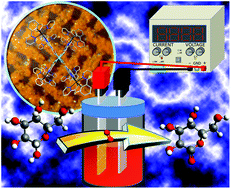Electrochemical synthesis, characterization of Ir–Zn containing coordination polymer, and application in oxygen and glucose sensing†
Abstract
A simple and sensitive biosensor array based on phosphorescence detection that is able to detect oxygen and glucose in human serum, respectively, has been developed. We demonstrate an electrochemical method as a fast, effective, tunable, and versatile means of growing phosphorescence sensing material. This sensing material, crystalline iridium(III)–Zn(II) coordination polymers, namely Ir–Zne, was grown on a stainless steel mesh and then doped in a sol–gel matrix. The emission of Ir–Zne was ascribed to a metal-to-ligand charge transfer transition (MLCT). The noteworthy oxygen-sensing properties of Ir–Zne were also evaluated. The optimal oxygen-sensing conditions of Ir–Zne with a deduced KSV value of 3.55 were 5 V and 30 °C for 1 hour. Moreover, the short response time (23 s) and the recovery time (21 s) toward oxygen have been measured. The reversibility experiment was carried out for eleven cycles. The resulting >70% recovery of intensity for Ir–Zne on each cycle demonstrated a high degree of reproducibility during the sensing process. The detection limit could be 0.050% for gaseous oxygen. The sensing substrate was subsequently built up under glucose oxidase encapsulated in hydrogel and then immobilized on an egg membrane by the layer-by-layer method. Once the glucose solution was injected into this array, oxygen content depleted simultaneously with a concomitant increase in the phosphorescence of coordination polymers. The linear dynamic range for the determination of glucose was 0.1–6.0 mM, the correlation coefficient (R2) was 0.9940 (y = 0.75 [glucose] + 0.539), and the response time was less than 120 s. The minimum detectable concentration for glucose was calculated to be 0.05 mM from three times signal to noise. The photophysical properties of the sensing material and the effects of buffer concentration, pH, interference, matrix effect, temperature, and the stability of the biosensor array have also been studied in detail. The biosensor array was successfully applied to the determination of glucose in human serum.


 Please wait while we load your content...
Please wait while we load your content...